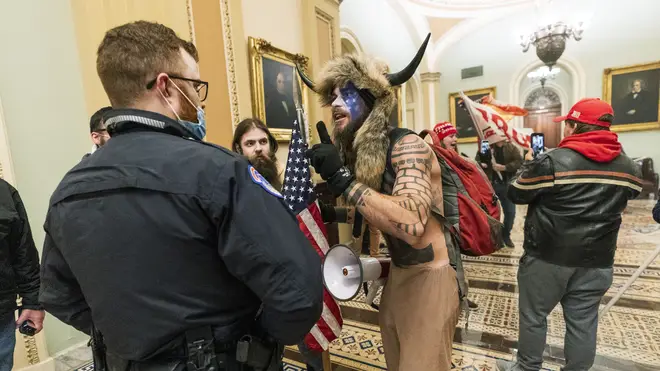
Ali Miraj 12pm - 3pm
13 January 2021, 02:24

The message contradicts earlier statements that law enforcement was caught off guard by the assault by supporters of President Donald Trump.
The FBI warned law enforcement agencies ahead of last week’s breach of the US Capitol about the potential for extremist-driven violence, officials have said.
The message contradicts earlier statements that law enforcement was caught off guard by the assault by supporters of President Donald Trump.
Nearly a week after the riot, officials said they were combing through mountains of evidence and vowed to aggressively seek out those who perpetrated the brazen attack on the US Capitol.
Though most of the charges brought so far have been misdemeanors, acting US attorney Michael Sherwin said the Justice Department was considering bringing sedition charges against some of the rioters, effectively accusing them of attempting to overthrow or defeat the government.
“This is only the beginning,” Mr Sherwin said.
“We’re going to focus on the most significant charges as a deterrent because, regardless of it was just a trespass in the Capitol or if someone planted a pipe bomb, you will be charged and you will be found.”
The Justice Department has created a specialised strike force to examine the possibility of sedition charges, which could carry up to 20 years in prison.
Officials said they were utilising some of the same techniques in the riot probe as they use in international counterterrorism investigations, examining the money flow and movement of defendants leading up to the breach.
Senate minority leader Chuck Schumer called for the rioters to be added to a no-fly list, a tool most commonly applied in foreign terror cases.
The statements by FBI and Justice Department officials on Tuesday were intended as both a defence of federal law enforcement preparations before the deadly riot and as a warning to participants.
But they also raised new questions about the coordination across agencies for the January 6 riot, which was sparked by Mr Trump’s calls for his supporters to fight Congress’ vote confirming President-elect Joe Biden’s victory.

In the immediate aftermath of the riot, some law enforcement officials, including the Capitol police chief, said they were unaware of serious concerns leading up to January 6 and had prepared only for a free-speech protest.
But on Tuesday, The Washington Post reported on the existence of a January 5 report from the FBI’s field office in Norfolk, Virginia, that forecast, in detail, the chances for “war” in Washington the following day.
Steven D’Antuono, the assistant director in charge of the FBI’s Washington field office, said that once he received the January 5 warning, it was shared with other law enforcement agencies within 40 minutes.
Mr D’Antuono was among the officials who suggested law enforcement had simply been caught off guard, saying on Friday: “There was no indication that there was anything other than First Amendment protected activity.”
He did not explain the discrepancy in his statements, though he suggested that the Norfolk warning was specific in terms of individual leads to investigate, characterising it as a “thread on a message board”.
US Capitol Police and other officials did not immediately respond to questions about their own initial assessments of the threat.
A US defence official familiar with the discussions said that Army Secretary Ryan McCarthy was not notified about the FBI warning.
The official, who spoke on condition of anonymity to discuss internal deliberations, said that it is unclear whether any defence or military officials heard about the notification from the FBI, but that statements in recent days from all the leaders indicate they were not aware that violence of that level was expected at the Capitol.
Even without intelligence from law enforcement, there had been ample warning about pro-Trump demonstrations in Washington.

But Capitol Police did not bolster staffing and made no preparations for the possibility that the planned protests could escalate into massive, violent riots, according to several people briefed on the law enforcement response.
Officials turned down help offered by the Pentagon three days before the riot.
When backup was finally requested, it took more than two hours for troops to mobilise near the Capitol. By then the mob had raged inside for more than four hours.
Once the mob began to move on the Capitol, a police lieutenant issued an order not to use deadly force, which explains why officers outside the building did not draw their weapons as the crowd closed in.
Officers are sometimes ordered to keep their weapons holstered to avoid escalating a situation if superiors believe doing so could lead to a stampede or a shootout.
In this instance, it also left officers with little ability to resist the mob. At least five people died in the riot, including one Capitol Police officer.